|
The
Akita Dilemma – One Breed or Two?
A historical perspective
By Dr.
Sophia Kaluzniacki, DVM
Published by kind
permission from
Dr. Sophia
Kaluzniacki, Tamarlane's Akitas.
Many of
you have heard about the controversy surrounding the current status of
the Akita. The Japan Kennel Club as well as AKIHO (the parent club in
Japan), do not consider our American Akitas to be true Akitas. Over the
last several years Japan has convinced the FCI countries to eliminate
any Akitas with pinto markings, black masks and any black color on the
body from any serious consideration at the shows. This has effectively
removed most of our American Akitas from competition in the FCI
countries. Since there seems to be more than a little confusion
surrounding this issue let me give you a little background.
According to Japanese history, the ancient ancestor of the Akita was the
Matagi-inu. Matagi-inu means hunting dog. As time went on, and the
social history of the Japanese people developed, these hunting dogs were
changed in conformation and temperament so they could also serve as
guard dogs and subsequently as fighting dogs. With the advent of
fighting, other breeds were crossed with the native Matagi-inu to
produce larger and fiercer fighting dogs. In the early 1900’s the
Japanese fanciers first became seriously interested in native Japanese
breeds, their purity and preservation. The Akita did not get its name
until 1931 when it, along with other native animals, was designated a
Natural Monument by the government.
Because Japan was almost constantly involved in wars, including World
War I and II, during the first half of the century there were very few
Akitas and three types of dogs were generally lumped together under the
name Akita. These were the Matagi Akita which was the original hunting
dog; the Fighting Akita which was a mixture of Matagi and several other
breeds including Mastiff and Great Dane; and the so called German
Shepherd Akita which was the result of breeders trying to save their
dogs from confiscation by the government. During the war the government
decreed that most dogs be confiscated and used as a source of fur for
military garments.
|
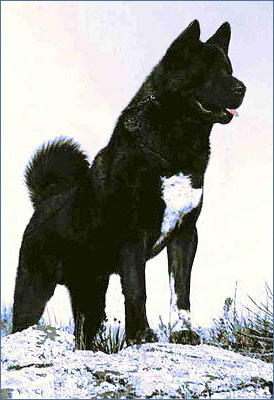
CH Tamarlane's Brigadoon ROM
Brigadoon was one of Tamarlane's Akitas
first Register of Merit Sires.
|
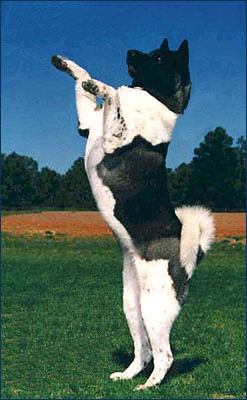
CH Tamarlane's Victoria San Tan
Victoria
is shown here as she appeared
on the cover of "Akita World" magazine
giving the "high five" upon the completion
of her championship.
|
Only German Shepherds were exempt because of their use as military dogs.
Many fanciers bred their Akitas to German Shepherds in order to avoid
them being killed for their coats. This, plus the fact that it was very
difficult to keep and feed large dogs during these very difficult times,
set the preservation process back considerably. Right after World War
II, servicemen brought many Akitas to the USA. Other fanciers who had
discovered this breed imported them up to the early 70’s. Most of these
dogs were of the Fighting Dog type and the German Shepherd type. These
were the Akitas most of us, including myself, fell in love with in the
60’, 70’s and 80’s.
The
Akita was fully recognized as a breed by the AKC in early 1973. At that
time, the doors were closed to further imports because the AKC did not
recognize the Japanese Kennel Club. Meanwhile, in Japan the restoration
process was in full swing. But even in Japan there was not total
agreement as to what constituted the true Akita. There were five
organization, all with their own standard promoting their version of the
breed. The organization that became dominant, and is today the parent
club for the breed in Japan, is known as AKIHO. Largely through the
efforts of this club and its breeders the Akita in Japan changed
dramatically from the dog found right after World War II.
The
Japanese breeders decided that the true Akita was the ancient Matagi, or
hunting type. The Fighting Akita type was also deemed incorrect because
of the many foreign breeds that had been introduced over the past
several hundred years in order to create it. Certainly, the German
Shepherd type, a necessity because of the war, was not desired. In spite
of the fact that the Akita breeders in Japan chose to promote the Matagi
Akita, it must be understood that not only the Matagi Akita, but also
the Fighting Akitas, are both historically Japanese breeds.
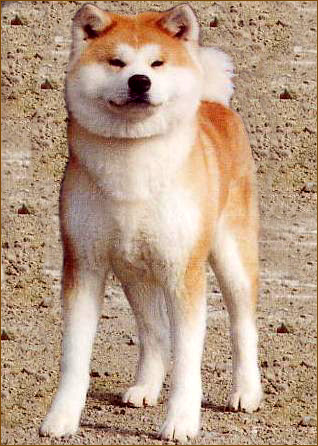
Typical
Japanese Akita
Note the
significant difference in type between
the Japanese Akita, today called Akita, and the American type,
today called American Akita.
During the years 2000 - 2006 the latter was called Great
Japanese Dog (GJD).
|
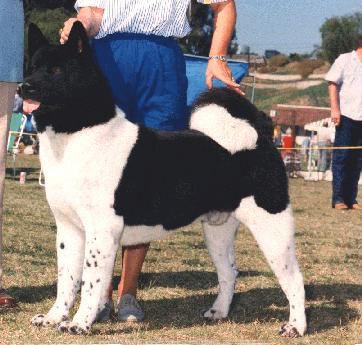
BIS, BISS USCH GBCH
Tamarlane's Veni Vidi Vici ROM
"Victor" was one of Tamarlane's
top winning Akitas. He completed his championship from the puppy
class and won two group firsts before one year of age. He won an
Award of Merit at the 1986 Akita National Specialty and Best of
Breed at the 1987 Akita National. Victor was the number one
Akita in the US in 1986 and was in the top three for three years
in a row. He was leased to Mike Window and Marion Sargent in
England for two years, where he became the first Akita champion
and the first Akita to win Best in Show at a championship show.
He was the top winning Akita in England.
|
About
three years ago several FCI countries petitioned the FCI to consider
splitting the Akita into two breeds. After all, there were many breeders
in the FCI countries who owned and bred what became known as the
American Akita, yet they could not show them and in some cases they
could not even register them. In response, JKC organized the first World
Akita Conference that was held in December 1996 in Tokyo. At this
conference, which I attended along with ACA president Nancy Henry, and
included representatives of 14 countries, it was decided that the
American type of Akita and the Japanese Akita were two different breeds
and should be shown separately and not be interbred. JKC would have
liked to have AKC and The Akita Club of America to also split the Akita
into two breeds at the same time that FCI does this.
To that
end, representatives from JKC had several meetings with both the Akita
Club of America and AKC to present and discuss the issue. However, here
in the US, it is not merely a function of a governing body such as the
AKC to make this change. It requires a two-thirds majority vote of the
membership of the parent club to affect any changes. Because of the
Akita Club of America’s undecided position on the issue of a breed split
and the JKC’s wishes to effect the split in FCI concurrently with a
split in the US, the whole issue became a highly charged statemate in
the FCI. On June 10, 1998, a letter signed by 24 FCI member countries
was presented to the FCI board. It stated in part: "Since the Japan
Kennel Club has officially admitted, before the present General Assembly
of FCI, that two different breeds of Akita do indeed exist, and since
one of these two breeds was developed not in Japan but in USA, it has
become urgent to recognize that breed formally, under the patronage of
FCI."
|
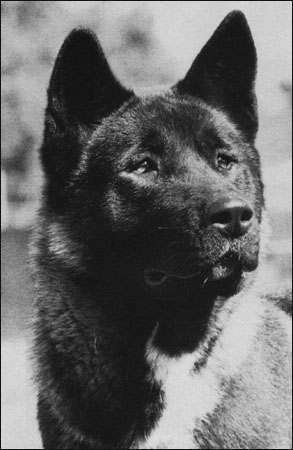
Photo©Akitas by Edita Van Der Lyn
CH Akita Tani's Yoru Bara, CD
- first Group placing Akita bitch.
Owners: Tom & Sandy Ing. |
A
second World Akita Conference was held in Haam, Germany in December of
1998. I also attended this meeting along with Akita Club of America
president, Rita Biddle and ACA treasurer Steve Lisker. At this meeting,
it was again decided that the Akita would be divided into two breeds in
the FCI countries as soon as possible. JKC then made a formal proposal
for an Akita breed split to the FCI. This proposal has the support of
both the Scientific Commission as well as the Standards Commission of
the FCI.
It will
now be voted on by the FCI General Assembly in June, just before the
World Show in Mexico City.The vote by the General Assembly is
essentially a ratifying vote to accept what the FCI has already
approved. All indications are that it will be passed by an overwhelming
majority. Much to the dismay of American breeders and breeders of
American type Akitas in other countries, the name for the American type
will be, at least for now, Great Japanese Dog. (Since this article has
been written the FCI has officially divided the Akita into two breeds.)
Today
we not only have American Akitas that cannot be shown or bred under FCI
rules in the FCI countries, but also Japanese Akitas whose breeders and
fanciers would like to have their dogs compete for AKC championships
under their own standard and against their own type. In the FCI
countries, the American Akita is the minority, while in the US it is the
Japanese Akita that is at a disadvantage. |
So just
how do these dogs differ? The differences are so great that it is very
much like comparing Malamutes to Siberian Huskies. The Japanese dogs are
not as large or massive and heavy boned as ours. They are square in
proportion and have a much more pronounced tuck-up. The head proportions
are more 50/50 whereas our standard call for a 40/60 (as two is to
three) ratio between muzzle and top skull. Our standard allows all
colors whereas the Japanese dogs are only allowed to be red, white or
brindle with no pintos or black masks. Red and brindle dogs are required
to have white shading on face, chest, inside of legs and under tail. In
general the Japanese dogs have a striking resemblance to Shibas, but in
a much larger size.
The
problem of the two very divergent types has for all practical purposes
been solved in the FCI countries. In fact American Akitas are now being
exported in greater numbers to Europe and a few have already been
exported to Japan in anticipation of the split into two breeds. In the
US however, there is as much dissention amongst the fanciers as there
was previously in the FCI countries. Many breeders want to split into
two breeds and just as many do not. It is an issue that has generated a
huge amount of debate. The Akita Club of America will be voting on
whether to split the breed or not in the near future. My personal
feelings are that the dogs are so totally different that a split into
two breeds would be best for the breeds. How the ACA membership decides
however, remains to be seen.
Addendum: Since this article was written two significant events
have occured. First the FCI has officially split the Akita intow
two breeds. The two are now known as the Japanese Akita and the
Great Japanese Dog (formerly American Akita) and compete in two separate
groups. The name "Great Japanese Dog" for the American type was
politically motivated and has not made breeders of American Akitas
happy. Second, a straw poll to consider a split of the breed in
the US was not passed by the membership of the Akita Club of America.
This means that we will have to live with this dilemma for a few more
years. In the meantime the Japanese Akita Club of America
has been formed and is in the process of seeking recognition through the
United Kennel Club.
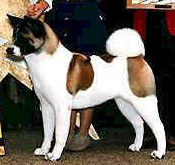
Pictures of the Tamarlane's Akitas with
kind permission from Akitas of Tamarlane.
|